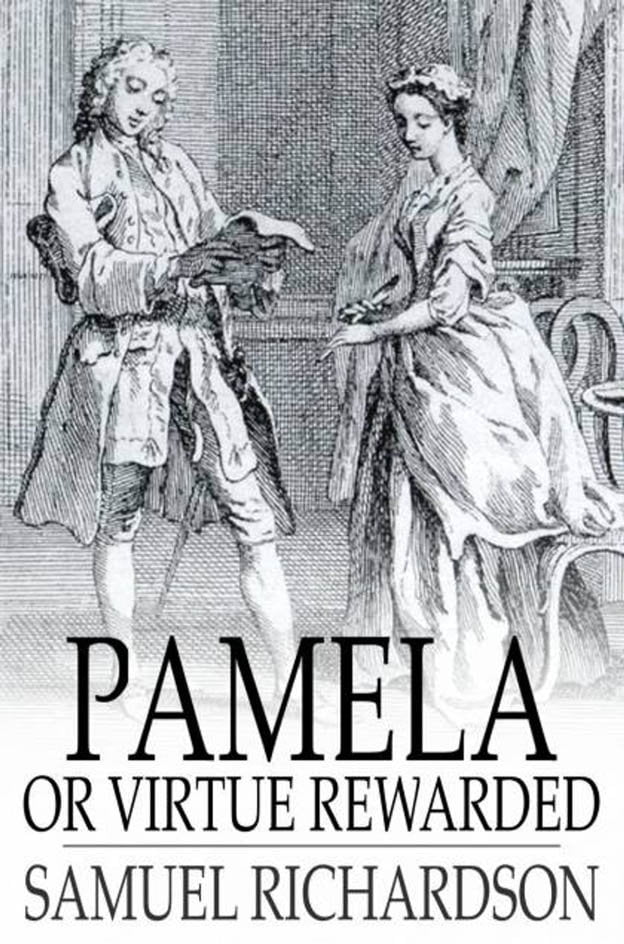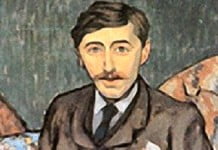Pamela or Virtue Rewarded is an epistolary novel by Samuel Richardson, first published in 1740. It is considered one of the earliest examples of the English novel and is significant for its exploration of themes such as social class, morality, and the role of women in society. The novel tells the story of a maid named Pamela whose master, Mr B, makes unwanted advances towards her. She rejects him continually, and her virtue is eventually rewarded when he shows his sincerity by proposing an equitable marriage to her. In the novel’s second part, Pamela attempts to accommodate herself in upper-class society and build a successful relationship with him. The story was widely mocked at the time for its perceived licentiousness, and it inspired Henry Fielding (among many others) to write two parodies: Shamela (1741), about Pamela’s true identity, and Joseph Andrews (1742), about Pamela’s brother.
Epistolarity
Epistolary novels, that is, novels written as a series of letters, were extremely popular during the 18th century, and it was Richardson’s Pamela that made them so. Richardson and other novelists of his time argued that the letter allowed the reader greater access to a character’s thoughts – Richardson claimed that he was writing “to the moment,” that is, that Pamela’s thoughts were recorded nearly simultaneously with her actions.
In the novel, Pamela writes two kinds of letters. At the novel’s beginning, while she is deciding how long to stay at Mr B’s after the death of his mother, she writes letters to her parents relating her various moral dilemmas and asking for their advice. After Mr B abducts her and imprisons her in his country house, she continues to write letters to her parents. Still, because she is unsure whether or not her parents will ever receive them, they are to be considered both letters and a diary.
In Pamela, the reader receives only Pamela’s thoughts and letters, restricting the reader’s access to the other characters; we see only Pamela’s perception of them. In Richardson’s other novels, Clarissa (1748) and Sir Charles Grandison (1753), the reader is privy to the letters of several characters and can thus more effectively evaluate the motivations and moral values of the characters.

Summary
Volume 1
Pamela Andrews is a young servant of 15, very pious and innocent, serving Lady B as a waiting-maid in Bedfordshire. When the lady dies, her son, the squire Mr B, shows more and more his attraction towards Pamela, first by being kind to her (he gives her his mother’s clothes), then by trying to take advantage of her in the Summer House. But she resists, and as he wants to pay her to keep the secret, she refuses and tells Mrs Jervis, the housekeeper, her best friend, a motherly figure. However, faithful to Mr B, Pamela thinks of returning to her impoverished parents to preserve her innocence, but she can’t decide. Mr B plans to marry her to Mr Williams, his chaplain in Lincolnshire and gives money to her parents in case she then lets him take advantage of her. She refuses and decides to go back to her parents.
But Mr B intercepts her letters to her parents and tells them she has an affair with a poor clergyman and that he will send her to a safe place to preserve her honour. Therefore, Pamela is driven to Lincolnshire Estate and begins a Journal (because she is a prisoner and can’t write letters anymore), hoping it will be sent to her parents one day. The housekeeper there, Mrs Jewkes, is very different from Mrs Jervis: she is a vulgar, rude, masculine woman devoted to Mr B. She imposes Pamela to be her bedfellow. Mr B promises he won’t approach her without her leave (indeed, he’s been away from Lincolnshire for a long time).
Pamela meets Mr Williams, and they agree to communicate by putting letters under a sunflower in the garden. Mrs Jewkes beats her because she calls her “her Jezebel”. Mr Williams asks the village gentry for help, and even though they pity Pamela, no one agrees to help her because of Mr B’s social position. Mr Williams proposes marriage to her to escape Mr B’s wickedness.
Mr Williams is attacked and beaten by robbers. Pamela wants to escape when Mrs Jewkes is away but is frightened by two bulls watching her (they are cows). By mistake, Mr Williams reveals the correspondence to Mrs Jewkes, and as a result, Mr B is jealous and says he hates Pamela. He wants to marry her to one of his servants. Mr Williams is arrested. Pamela is desperate; she thinks of running away and making them believe she has drowned in the pond. She tries to climb a wall but can’t do it; she is injured and renounces escape.
Mr B comes back. He sends her a list of Articles that would rule their partnership; she refuses each point because it would mean being his mistress. Mr B tries to go to bed with her disguised as Nan (the housemaid) with the collaboration of Mrs Jewkes. But Pamela faints and thwarts his designs. He seems to repent then; he is kinder in trying to seduce her. She implores him to cease. When he talks to her in the garden, he implicitly says he loves her but can’t marry her because of the social gap.
Volume 2
A gipsy fortune-teller wants to predict Pamela’s future, but only to give her a bit of paper warning her against a sham marriage. Pamela has hidden a parcel of letters under a rose bush, and when she comes to take them back, Mrs Jewkes seizes them and gives them to Mr B. After reading the letters, Mr B feels pity for what she has undergone because of him and decides to marry her.
But she still doubts him and begs him to let her return to her parents. He is vexed but lets her go. She bids him goodbye and feels strangely sad. On her way home, he sends her a letter wishing her a good life. Pamela is moved and realizes she is in love. Then he sends her a second paper asking her to return because he’s very ill; she accepts. Mr B’s sister, Lady Davers, is very cross with him for taking Pamela as his wife.
Pamela and Mr B talk of their future life as husband and wife, and she agrees with everything he says. She explains why she doubted him. This is the end of her trials: she is more submissive to him and owes him everything now as a wife. Mr Williams is released. Some neighbours come to the estate, and all admire Pamela. Pamela’s father comes to take her away, but he is reassured when he sees Pamela happy.
Finally, she marries Mr B in the chapel. But when Mr B goes to see a sick man, Lady Davers comes to threaten Pamela and considers she is not married. Pamela escapes by the window and goes in Colbrand’s chariot to be taken away by Mr B. The following day, Lady Davers enters their room without permission and insults Pamela. Mr B is furious; he wants to renounce his sister, but Pamela wants to reconcile them. But Lady Davers is still contemptuous towards Pamela. Vexed, she mentions Sally Godfrey, a girl Mr B seduced in his youth, with whom he had a child. He is cross with Pamela because she dared approach him when he was in a temper.
Lady Davers accepts Pamela. Mr B explains to Pamela what he expects of his wife. They go back to Bedfordshire. Pamela rewards the good servants with money and forgives John, who betrayed her. They make a little “Airing” to a farmhouse and encounter Miss Goodwin, Mr B’s child. Pamela would like to take her with them. They learn that Sally Godfrey now lives happily in Jamaica with a husband. Pamela is praised by the gentry of the neighbourhood, who once despised her.
Innovative Narrative Form
Pamela is written in the form of a series of letters, a technique known as the epistolary novel. This format allows for a direct and intimate portrayal of the protagonist’s thoughts, emotions, and experiences, providing readers with a compelling insight into Pamela’s inner world.
Character Development
One of Pamela‘s strengths is its nuanced portrayal of characters, particularly the protagonist, Pamela Andrews. Pamela is depicted as a virtuous and resilient young woman who faces numerous trials and tribulations throughout the novel. Her growth and development over the course of the story, as she navigates the challenges of her social status and the advances of her employer, Mr B, are central to the novel’s narrative.
Exploration of Morality and Virtue
At its core, Pamela is a moral tale that celebrates the virtues of honesty, integrity, and perseverance. Pamela’s steadfast commitment to her principles in the face of temptation and adversity is a model of virtuous behaviour and moral rectitude. The novel’s title, Virtue Rewarded, underscores the theme of moral justice and the belief that goodness will ultimately triumph over evil.
Social Commentary
Pamela offers a revealing commentary on the social mores and class distinctions of 18th-century England. Through Pamela’s experiences as a servant in a wealthy household, the novel exposes the power dynamics and inequalities inherent in Georgian society. Richardson explores issues such as class prejudice, gender inequality, and the exploitation of the lower classes, shedding light on the injustices faced by women and servants in the patriarchal society of the time.
Literary Influence
Pamela significantly influenced the development of the English novel and the emergence of the novel of manners. Richardson’s innovative narrative techniques, psychological depth, and moral seriousness paved the way for later novelists like Jane Austen and Henry Fielding. Pamela also sparked widespread debate and controversy upon its publication, provoking discussions about morality, gender roles, and the purpose of literature.
Critique and Interpretation
While Pamela has been praised for its moral earnestness and psychological realism, it has also been criticised for its sentimentalism and didacticism. Some readers have found fault with Richardson’s idealised portrayal of Pamela as a paragon of virtue, arguing that it reflects outdated notions of female passivity and subservience. Others have questioned the novel’s resolution, in which Pamela’s marriage to Mr B is presented as a happy ending despite his earlier attempts to seduce her.
Pamela or Virtue Rewarded is a landmark work of English literature that remains relevant and thought-provoking today. Its exploration of morality, social class, and gender dynamics, as well as its innovative narrative form, continue to captivate readers and inspire critical analysis and interpretation.






























